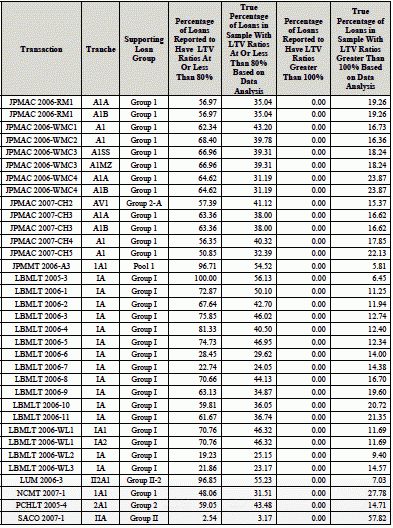(Article changed on December 13, 2013 at 20:33)
(Article changed on December 12, 2013 at 22:41)
Investors
won't finance underwater mortgages. Just look at the 122 residential
mortgage-backed securitizations referenced in the lawsuit filed by the Federal
Housing Finance Agency against JPMorgan. Every one of those deals was sold with
the claim that the pool had zero mortgages with a loan-to-value in excess of 100%.
But the opposite was true. At the time of closing, all 122 deals held a
material number of mortgages that exceeded the value of the property.
The uniformity is striking, as can be seen on Table 8 in the J.P. Morgan complaint (page 130), or Table 7 of the Goldman Sachs complaint (page 52), or Table 9 of the Merrill Lynch complaint ( page 63), or Table 7 in the Royal Bank of Scotland complaint (page 52), or tables in a dozen other lawsuits filed by FHFA on behalf of Fannie Mae and Freddie Mac.
It's hard to summarize the damning evidence set forth all 18 lawsuits, but a quick glimpse at those tables gives you a sense of a widespread disregard for accuracy in S.E.C. filings.
Those numbers understate the magnitude of the problem. They reflect, for the most part, only first lien LTVs, and not simultaneous 2nd lien debt, which also encumbered the collateral. (Many of these deals had small percentages, usually 5% or less, of 2nd lien loans, for which the combined LTV was used in the complaints' calculations.)
For instance, the prospectus for J.P. Morgan Mortgage Acquisition Corp. 2006-CH2 , which financed only first-lien mortgages, stated there were zero mortgages with an LTV in excess of 100%. In fact, a subsequent review showed that 20% had mortgages that exceeded the value of the collateral. Allstate Insurance conducted another review of the JPMAC 2006-CH2 loan files, and found that 44% of the mortgages had CLTVs that exceeded the property values. As you would expect, underwater mortgages perform poorly when home prices start sliding.
That's not the half of it. FHFA also presented an abundance of evidence that the underwriting banks seriously overstated the percentages of owner occupancy in each mortgage pool. And, the plaintiffs allege, there was an abundance of other evidence that banks simply disregarded their stated credit standards.
To test the veracity of the banks' statements, the FHFA had reviews conducted for 1,000 files in each loan group. So, for instance, the JPMorgan complaint involved reviews of about 122,000 loan files. No easy, or inexpensive, task. The total review, of hundreds of thousands of different loan files, may be the most comprehensive study of RMBS collateral anywhere. FHFA's lawyers should donate their work product to the National Archives.
In addition to evaluating the documentation, the reviewers scanned tax records and lien filings to confirm whether the borrower actually resided at the mortgaged property as he claimed. And with each file, the reviewer compared the lien loan amount with the values shown by a well-recognized automated valuation model, or AVM. As CoreLogic states, retrospective AVMs tend to be more accurate than original AVMs.
The specifics of these complaints are important, because they dispel the false media narrative being pushed by certain lawyers and commentators. These cases are not about the government sponsored enterprises and their knowledge of mortgage risk. These cases are about lying. Moreover, these lies were not made to Fannie and Freddie, but to anyone who bought in to those deals.
The lies began with the origination of mortgages, which were not adequately vetted by the bond underwriters, who, under the Securities Act of 1933, are legally liable for the accuracy and completeness of public filings. All sophisticated investors know that the 1933 Act holds the underwriters accountable for the accuracy of the information. Which is why any argument insinuating that the GSEs "knew what they were buying" is spurious.
Bloomberg BNA estimates that GSEs could recover up to $28 billion in settlements for bond purchases that totaled $200 billion. But this is the tip of the iceberg.
Because the GSEs almost always purchased the most senior triple-A tranche in a deal, they were supposed to recover all principal before subordinate tranches recovered a nickel. So, to the extent that a GSE suffered a loss on any deal, the subordinate tranches got wiped out.
Consider J.P. Morgan Mortgage Acquisition Corp. 2006-CH1, a $600 million deal comprised entirely of 1st lien loans. At the time of closing, about 17% of the Group 1 mortgages had an LTV higher than 100%. Moody's estimates that the entire deal will suffer $191 million in losses. But the GSE investment, a $150 million triple-A tranche, will be paid back in full
(Note: You can view every article as one long page if you sign up as an Advocate Member, or higher).





